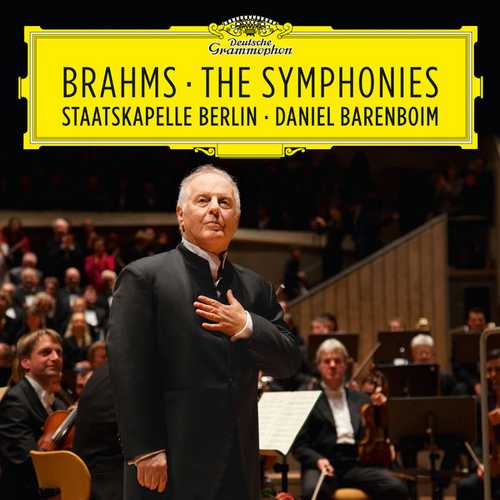
Composer: Johannes Brahms
Performer:
Orchestra: Staatskapelle Berlin
Conductor: Daniel Barenboim
Format: FLAC (tracks)
Label: Deutsche Grammophon
Catalogue: 4835251
Release: 2018
Size: 747 MB
Recovery: +3%
Scan: yes
Symphony No. 1 in C minor, Op. 68
01. 1. Un poco sostenuto – Allegro – Meno allegro
02. 2. Andante sostenuto
03. 3. Un poco allegretto e grazioso
04. 4. Adagio – Piu andante – Allegro non troppo, ma con brio – Piu allegro
Symphony No. 2 in D major, Op. 73
05. 1. Allegro non troppo
06. 2. Adagio non troppo – L’istesso tempo, ma grazioso
07. 3. Allegretto grazioso (Quasi andantino) – Presto ma non assai
08. 4. Allegro con spirito
Symphony No. 3 in F major, Op. 90
09. 1. Allegro con brio – Un poco sostenuto – Tempo I
10. 2. Andante
11. 3. Poco allegretto
12. 4. Allegro
Symphony No. 4 in E minor, Op. 98
13. 1. Allegro non troppo
14. 2. Andante moderato
15. 3. Allegro giocoso – Poco meno presto – Tempo I
16. 4. Allegro energico e passionato – Più allegro
The Staatskapelle Berlin is one of the European orchestras whose primary mission has been opera. The group has increasingly played symphonic repertory as well, but perhaps there’s a dramatic orientation toward their work. Whatever the explanation, the orchestra was the perfect vehicle for Daniel Barenboim’s latest thinking on the Brahms symphonies. His readings are broad and detailed, with the four symphonies differentiated almost as if they were operas. The Symphony No. 2 in D major, Op. 73, fully emerges here as the Pastoral Symphony answer to the explicitly Beethovenian Symphony No. 1 in C minor, Op. 68; sample especially the finale, a massive, intoxicated dithyramb. So it is all the way through; the passacaglia finale of the Symphony No. 4 in E minor, Op. 98, is no incipient neo-Baroqueness but a sweeping piece of pure impulse (which makes sense, given that Beethoven thought of Baroque forms this way). This is arch-Romantic Brahms, untouched by contemporary minimal thinking, and it seems to have decades of tradition behind it even if Barenboim’s association with this orchestra is fairly recent. It is also a triumph of the conductor’s art, worked out vividly in even the smallest details. These live performances, recorded at the Pierre Boulez Saal in Berlin, have immediacy and power, and it may be that what Barenboim has accomplished here was not really suited to studio work.